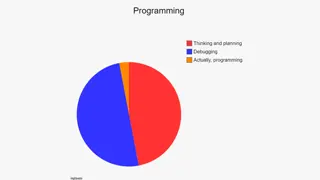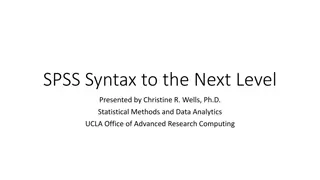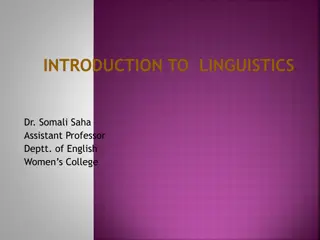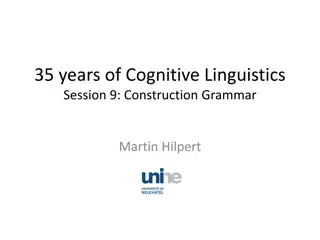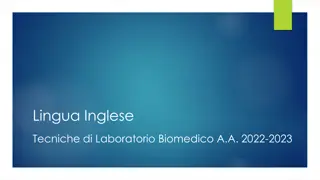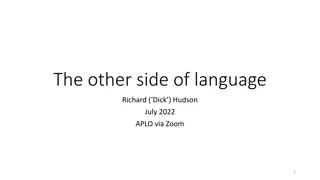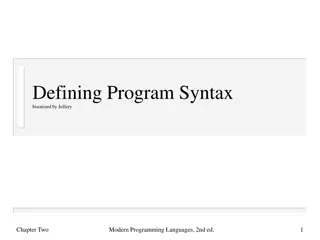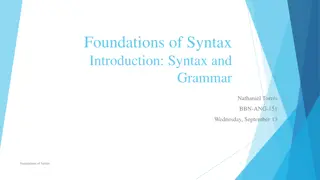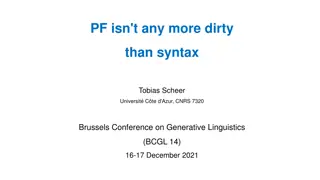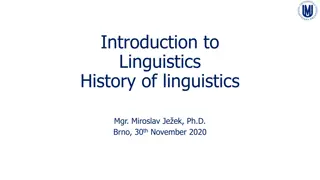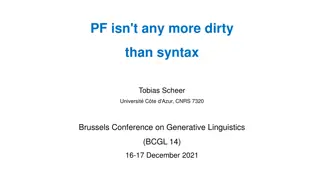Understanding Syntax in Linguistics
Syntax, originating from Greek meaning arrangement, deals with the structure of sentences in a language. Generative Grammar, coined by Noam Chomsky, uses rules akin to mathematics to create new, grammatically accurate sentences. By applying recursion and deep structure analysis, linguists explore the complexity and infinite possibilities of language generation.
Download Presentation

Please find below an Image/Link to download the presentation.
The content on the website is provided AS IS for your information and personal use only. It may not be sold, licensed, or shared on other websites without obtaining consent from the author. Download presentation by click this link. If you encounter any issues during the download, it is possible that the publisher has removed the file from their server.
E N D
Presentation Transcript
University of Basrah College of Arts Department of Translation Third Year Linguistics Syntax 1+ 2
Syntax The word syntax comes originally from Greek and literally means a putting together or arrangement. It is concerned with the possible arrangement of words in a language . The basic unit in syntax is the sentence which minimally consists of a main close ( S + V). Generative Grammar It is a term coined by the famous linguist Noam Chomsky in 1957 to refer to the type of grammar that has a very explicit system of Rules which has a lot in common with the types of rules found in Mathematics. Accordingly, a language ( Any Language) has the characteristics of being a set of finite or infinite sentences. So, a GG has the ability to create totally Novel ( New ) and grammatically accurate sentences.
To illustrate, in Mathematics, we have a set of finite number of Rules that can generate an infinite number of Values: Ex. 3x + 2y = ? If ( X ) = 5 and ( Y) = 10 the formula becomes as the following : 3x5 + 2x10 = 35 So, whenever we give a value to ( X ) & ( Y ) we shall have a new result, and this means that, we can generate an Infinite values using the same basic elements; i.e. We can generate an endless set of values by following the simple rules of Mathematics. The same is true for language, we have a set of finite number of rules, that can generate an infinite number of grammatically accurate sentences by following the basic Simple Rules.
To give more explanation, when we have an effective rule such as a prepositional phrase in English consists of a preposition followed by a noun phrase, we can imagine an extremely large number of English phrases that could be produced using this rule. In fact, the potential number is unlimited. This reflects another goal of syntactic analysis, which is to have a small and finite (i.e. limited) set of rules that will be capable of producing a large and potentially infinite (i.e. unlimited) number of well-formed structures. This small and finite set of rules is described as a Generative Grammar because it can be used to generate or produce sentence structures and not just describe them.
Recursion It means that the rules of a Grammar have the ability to be applied more than once in generating a sentence ( structure) either by repeating a phrase as often as required, or by generating a sentence inside another one: Prep. P. Prep.P Ex.1. The gun was on the table, near the window. ( Repeating a Phrase) 2. John believed that Cathy knew that Marry helped George. ( sentence inside another sentence)
Deep and Surface Structure Deep Structure: it is the abstract level of the structural organization in which all the elements determining structural interpretation are represented. Surface Structure: it is the representation of the structural interpretation of a sentence. So, a GG has the ability of showing how a single underlying abstract representation can become the source of different surface structures, i.e. in a GG, the same Deep Structure can be the source of many other Surface Structures: - Charlie broke the window. - It was Charlie who broke the window. - The window was broken by Charlie. - Was the window broken by Charlie? - Kate washes the dishes. - The dishes was washed by Kate. - It was Kate who washed the dishes. - Was it Kate who washes the dishes? As you can see above, in each example, all the 4 sentences ( Surface Structures) have the same Deep Structure.
Structural Ambiguity It means that a sentence has two distinct underlying interpretations which represented in One Surface Structure. That is to say that , Structural Ambiguity happens when a sentence has two different Deep Structures, but only One Surface Structure: Ex. They saw the man with the telescope. ( SS) Deep Structures: 1. They saw the man by using a telescope. 2. They saw a man carries a telescope.
Syntactic Structure Since any language has this set of explicit rules which are limited in number, but can generate an unlimited number of accurate and Novel sentences, this means that: any language has its own Syntactical Structure, i.e. it can generate ( all and only) well-formed sentences: Syntactical Structure The ability to generate Sentences that are superficially different, but they are closely related: - Charlie broke the window. (Active) - The window was broken by Charlie. ( Passive ) The Ability to generate sentences that are superficially similar, but they are different in meanings: - He reads this book. (SVO) - She washes the dishes. ( SVO) In both cases, Sentences should be well formed ones.
Syntactic Analysis ( Description) To be able to represent the syntactic information in a more dynamic format, the following are the most commonly used ( Symbols ) in syntactic analysis (description : 1. The first symbol is in the form of an ( arrow ) which is interpreted as ( consists of or ( rewrite . That is to say that, one way of presenting the concept consists of is with an arrow ( as. The following rule states that a noun phrase (NP) such as the dog consists of or rewrites as ( ) an article (the) and a noun (dog). This simple formula is the underlying structure of millions of different English phrases. NP Art.+ N 2. The second symbol is a Pair of round brackets ( ) . It means that, anything occurs inside these round brackets will be treated as an OPTIONAL CONSTITUENT eg. She hits the ( small) cat. ), also interpreted as rewrite
3. The third common symbol is the form of curly brackets { }. These indicate that only one of the elements enclosed within the curly brackets must be selected: eg. NP { Art + N Only one choice should be selected when we are going to generate a sentence. (Adj.) +N Pro. Prep. + NP Proper N } 4.The forth symbol is the DoubleArrow ( transformed to : Active ) which is interpreted as passive Transformed to eg. -We made mistakes. Mistakes were made. - The cat kills the mice. The mice are killed by the cat. - He will write a letter. The letter will be written by him.
5. The following are the rest of the symbols that are used in Syntactic description : No. Symbol Full term No. Symbol Full Term 1 S Sentence 9 Pp. Prepositional phrase 2 N Noun 10 NP Noun phrase 3 V Verb 11 VP Verb phrase 4 Art Article 12 CP Complemented phrase 5 PN Proper Noun 13 Pro. Pronoun 6 Adv. Adverb 14 Aux. Auxiliary verb 7 Adj. Adjective 15 C Complementizer ( eg. Who, that, which, etc.) Ungrammatical Sentence 8 Pre. Preposition 16 *
Phrase Structure Rules They are the Rules that refer to the different level of Syntactic analysis of a sentence, showing its structure of NP and VP: S NP + VP eg. Mary saw George recently NP { Art. +( Adj.) + N ,Pro. , PN} eg. The beautiful child , They, We, Mary, John. VP V+ NP ( Pp), (Adv. ) washes the dishes (by herself), yesterday. Pp Prep. + NP by train, with his father, near the window .
Lexical Rules Phrase structure rules generate structures. In order to turn those structures into recognizable English, we also need lexical rules that specify which words can be used when we rewrite constituents such as PN. The first rule in the following set states that a proper noun rewrites as John or Mary. (It is a very small world.) PN {John, Mary} Art {a, the} N {girl, dog, boy} Adj {big, small} V {followed, helped, saw} Pro {it, you} We can rely on these rules to generate the grammatical sentences shown below in (1) (6), but not the ungrammatical sentences shown in (7) (12). (1) Adog followed the boy. (7) *Dog followed boy. (2) You saw it. (8) *You it saw. (3) John saw the big dog. (9) *John Mary small dog (4) It followed Mary. (10) *Followed Mary the dog big. (5) The small boy helped you. (11) *The helped you boy (6) Mary helped John. (12 *Mary John helped.
Transformational Rules They are the rules that take a specific art of structure away from one art and attached it to a different part. Transformational rules also used to derive English questions structures from sentences S S Transformed NP VP Adv. NP VP PN V NP Adv. V NP PN Mary saw George recently PN Recently Mary saw George
S S Transformed NP Aux. VP Aux. NP VP Pro. V NP Pro. V NP PN PN You will help Cathy. Will you help Cathy An Interrogative Sentence A declarative Sentence
Tree Diagrams One of the best ways to create a visual representation of underlying syntactic structure is through tree diagrams. We can use the symbols introduced earlier to label parts of the tree when we create a representation of how each part fits into the underlying structure of phrases. The information in a phrase structure rule, on the left, can be expressed in a tree diagram, on the right, as in the following figure. Although this kind of tree, with its branches, on the right, seems to grow down rather than up, it functions rather well as a diagram representing all the grammatical information found in the other analysis on the left. It also shows very explicitly that there are different levels in the analysis. That is, there is a level of analysis at which a constituent such as NP is represented and a different, lower, level at which a constituent such as N is represented.
We can use a similar tree diagram to represent the more complex structure of an English verb phrase (VP), as shown in the previous figure. Once again, this type of diagram provides a way of representing the hierarchical nature of underlying structure. In this hierarchy, the verb phrase (VP) in higher than and contains the verb (V) and a noun phrase (NP). The noun phrase (NP) is higher than and contains the article (Art) and the noun (N). Tree Diagrams of English Sentences We can now put together tree diagrams for whole sentences, hierarchically organized, as shown in the figure above. Notice that essentially the same basic tree diagram structure is the foundation for all the different sentences (1) (6), with variable constituents included in each one.
S NP VP V CP C S NP VP PN PN V CP C S NP VP PN V NP PN John believed that Cathy knew that Mary helped George.




